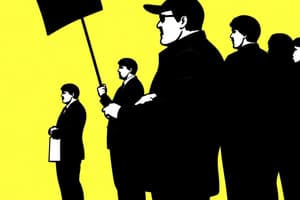Podcast
Questions and Answers
What impact did railroad construction have on economic development?
What impact did railroad construction have on economic development?
- It reduced the need for factories.
- It connected urban consumers with rural producers. (correct)
- It eliminated the need for labor unions.
- It created more small family-owned businesses.
How did industrialization affect workers' aspirations?
How did industrialization affect workers' aspirations?
- Workers' aspirations for economic independence grew.
- Workers preferred temporary jobs over permanent positions.
- Workers were able to attain small businesses more easily.
- Workers increasingly sought permanent employment. (correct)
What was the role of managers in the growing economic enterprises?
What was the role of managers in the growing economic enterprises?
- They were responsible for organizing labor unions.
- They disconnected owners from day-to-day operations. (correct)
- They took control of small businesses.
- They directly replaced factory workers.
What was a significant development in Chicago's meat production industry between 1866 and 1886?
What was a significant development in Chicago's meat production industry between 1866 and 1886?
What transformation occurred in the American landscape due to industrial meat production?
What transformation occurred in the American landscape due to industrial meat production?
What characterized the emergence of a new middle class during industrialization?
What characterized the emergence of a new middle class during industrialization?
Why was Chicago referred to as the Gateway City?
Why was Chicago referred to as the Gateway City?
Which of the following trends was NOT a result of industrialization?
Which of the following trends was NOT a result of industrialization?
What was the primary function of the fictitious Edison machine described in the April Fool's Day article?
What was the primary function of the fictitious Edison machine described in the April Fool's Day article?
Which of the following best describes Edison's approach to invention at his Menlo Park laboratory?
Which of the following best describes Edison's approach to invention at his Menlo Park laboratory?
What significant electrical development did Edison announce in September 1878?
What significant electrical development did Edison announce in September 1878?
What was Edison's vision for his 'invention factory' in terms of output?
What was Edison's vision for his 'invention factory' in terms of output?
What transformation did electricity bring to factories and cities?
What transformation did electricity bring to factories and cities?
Which of the following statements accurately describes the impact of Edison's innovations?
Which of the following statements accurately describes the impact of Edison's innovations?
What was a direct consequence of Edison's efforts in electric power by 1883?
What was a direct consequence of Edison's efforts in electric power by 1883?
How did Edison convince cities to build central power stations?
How did Edison convince cities to build central power stations?
What underlying principle was essential for Edison's electric power systems?
What underlying principle was essential for Edison's electric power systems?
Flashcards are hidden until you start studying
Study Notes
Economic Development and Labor Systems
- Railroad construction fueled economic development and new systems of labor emerged.
- Factory work shifted from a temporary role to a permanent wage-earning model post-war, diminishing small business aspirations among workers.
- Organized labor unions gained strength, advocating for the expanding working class.
Changes in Business Structure
- A disconnect grew between business owners and their employees as enterprises scaled up, necessitating managerial roles.
- Emerging middle class comprised educated bureaucrats managing vast operations.
Industrialization and Urbanization
- Rapid growth of industrialized cities integrated urban consumers with rural producers, forming a national market.
- Nationalization of food production occurred; significant in meatpacking with Chicago's stockyards as a hub.
- Between 1866-1886, over a million cattle were driven annually from Texas to Chicago for meat processing.
Transformation of Meat Production
- By 1885, Chicago's large-scale meatpackers produced nearly 500 million pounds of "dressed" beef each year.
- Agricultural landscapes transformed with the rise of cattle, corn, and wheat cultivation replacing natural habitats.
Technological Innovation
- Thomas Edison gained attention for proposing revolutionary inventions, including a fictitious food machine in 1878 that could produce food from air, water, and dirt, reflecting the era's technological optimism.
- Edison's work in electric power and lighting began in September 1878, merging management with inventive spirit.
The Menlo Park Research Laboratory
- Edison redefined the research and development landscape with his "invention factory" model at Menlo Park, pledging consistent output of inventions.
- By late 1879, he showcased electric power generation and lighting; scaled production began soon after.
Expansion of Electrical Power
- By 1883, Edison managed the construction of 330 plants, lighting over 60,000 lamps globally in various sectors.
- New York’s Pearl Street central station opened in September 1882, providing power to downtown Manhattan.
Impact of Electricity
- Electricity revolutionized industry: factories gained flexibility in operational hours and locations.
- Innovations included electric rail cars and elevators, which transformed urban infrastructure and facilitated city expansion.
Overall Transformation of the U.S.
- The Second Industrial Revolution marked a shift towards elevated productivity and unprecedented wealth accumulation.
- Increasing numbers of Americans became wage laborers; a vast "white-collar" middle class emerged alongside evolving social and cultural landscapes.
Studying That Suits You
Use AI to generate personalized quizzes and flashcards to suit your learning preferences.




